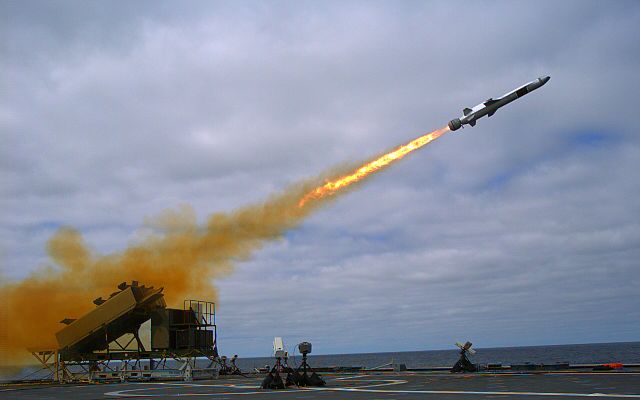
It’s great news that negotiations between Moderna and the federal and Victorian governments have resulted in Australia establishing a national facility to produce mRNA vaccines and medicines. Oddly, there are some parallels between this project for vaccine production and the government’s welcome decision to establish Australian manufacture of some of the advanced missiles our defence force uses.
Just as with Covid-19 vaccines, Australia is currently far too dependent on shaky global supply chains for the guided weapons used by the Australian Defence Force. Right now, not a single missile our military uses is made here in Australia, and the ADF plans to buy $100 billion worth of different missiles over the next 20 years; obviously more if it needs to use them in conflict. Just like vaccines, when our military want lots more missiles, everyone else will too, so national production is an essential priority.
And a manufacturing facility for mRNA vaccines is a high-technology, high-precision enterprise. Manufacturers guard their trade secrets and intellectual property closely, just as is the case with the US, European and Israeli missile manufacturers that currently supply Defence.
The last parallel is that making a big bet on a single vaccine can be risky. Fortunately, we already have the AstraZeneca production capability, and an mRNA factory can produce multiple different vaccines and variants more rapidly than more traditional vaccine development.
Moderna vaccine production locally will start in 2024. Everyone would like that to be faster, but two years from announcement to the first filled vials is timely implementation. Full maturity—and hopefully research and design capabilities for vaccines—will grow over 10 years.
All this has important lessons for how the government establishes a guided-weapon manufacturing facility or facilities. It’s possible to get some rapid results on national missile production early while larger, more mature production capacity is developed in slower time. None of this will happen if operating companies have to build the plant ‘on spec’ in the hope of government orders, perhaps, should there be a need. As with the Moderna facility, co-investment by governments and companies is what’s needed.
It’s wise to think ahead and not place all bets on just one weapon type for local production. As is the case with diseases, warfare too produces changed circumstances and surprises.
A local production approach should begin with Australia partnering with more than one of Defence’s current guided-weapon providers. Logically, at least one will be the current primary builder of weapons in the ADF inventory—the huge US Raytheon defence conglomerate and its successful local subsidiary.
But it’s also wise to have a parallel production track with other credible suppliers, particularly ones that will be unburdened by the intricate, slow-moving US laws and regulations governing defence exports and missile controls—the key obstacle to any accelerated production of US missile designs in Australia.
That probably means partnering with one or both of Kongsberg and Varley Rafael, manufacturers of the versatile Naval Strike Missile and Spike families of weapons, respectively, each likely to be able to move much faster on local production than even the most motivated US supplier. These Norwegian and Israeli companies are backed by their governments and so would bring crucial government-to-government research and development partnerships.
A national production approach will almost certainly include these and others working with Thales’s existing plants for propellant and explosive manufacture. It could also involve working with a ‘missile agnostic’ consortium like the Australian Missile Corporation to produce different missile designs, such as Raytheon’s, Northrop Grumman’s and Lockheed Martin’s, in a joint facility if intellectual property issues can be worked through.
The biggest lesson from the mRNA production deal, though, is that a sense of urgency can deliver rapid local production, even where there are webs of legal, intellectual property and commercial interests to be navigated, in an area in which Australia has related skills and capabilities but not as much in the way of applied experience or track record. It’s refreshing that both the federal and Victorian governments kept their eyes on the actual goal: removing the glaring vulnerability of being totally dependent on international supply chains and establishing early national production. Deeper capability being grown after this is part of the deal, but the eyes stayed on the prize.
The traditional Defence procurement answer would be less likely to do this. It would probably default to just buying in more stocks of missiles the ADF needs from current offshore production for the first few years, and emphasise that missile production requires a dense policy, regulatory and industrial ‘ecosystem’ that can only be created slowly. This would not disturb the traditional way Defence works with big US suppliers. The only thing this traditional procurement approach would not do is have an Australian-produced missile rolling off a local production line any time before 2030. We may not have the luxury of waiting that long.
So, the vaccine production decision is a bit of a pathfinder for rapid local production of missiles—and other areas beyond medicine—that can help streamline traditional planning and implementation.
 Print This Post
Print This Post